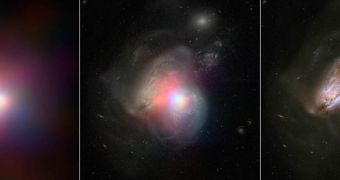Just yesterday, scientists with NASA released a series of images documenting the mash-up of two distant galaxies. The images in question were obtained with the help of the Nuclear Spectroscopic Telescope Array and the Hubble Space Telescope.
Astronomers who have taken the time to study the behavior of these colliding galaxies say that evidence indicates that they each harbor a supermassive black hole at its core. What's interesting is that, of these black holes, one appears to be a wee hyperactive and the other seems to be dormant.
Documenting a distant cosmic collision
In a report detailing their work, scientists with NASA explain that the colliding galaxies imaged with the help pf the Nuclear Spectroscopic Telescope Array and the Hubble Space Telescope are located at a distance of about 134 million light-years from our planet.
Together, they are known as Arp 299. Astronomers go on to detail that the galaxies sit in the constellation Ursa Major and are currently undergoing intense star formation processes. Apparently, it is precisely because of their merger that the cosmic systems are now forming stars at a rapid pace.
“When galaxies collide, gas is sloshed around and driven into their respective nuclei, fueling the growth of black holes and the formation of stars,” explains scientist Andrew Ptak with NASA's Goddard Space Flight Center in Greenbelt, Maryland.
The Dr. Jekyll and Mr. Hyde in these galaxies
As mentioned, these distant galaxies that form Arp 299 each hold a mammoth black hole at their center. The thing is that, according to Nuclear Spectroscopic Telescopic Array data, one of these black holes is a regular Dr. Jekyll while the other is a much calmer Mr. Hyde.
In a nutshell, astronomers say that, of the two supermassive black holes, the one on the right is now busy gobbling up gas at a mind-bogglingly rapid pace and, consequently, accumulating mass. Because of its hearty appetite, the black hole is producing massive amounts of high-energy X-rays.
Scientists add that these high-energy X-rays are the result of the fact that, while the black hole is feeding, the electrons and protons in its proximity get heated to hundreds of millions of degrees. The result is the birth of insanely hot plasma that in turn births the X-rays.
The weird thing is that astronomers have so far been unable to detect any high-energy X-rays originating from the black hole on the left. It is believed that this is either because the black hole is buried in massive amounts of gas and dust, or simply because this region is in a dormant state.
In case anyone was wondering, the reason NASA astronomers are so preoccupied making heads or Tails of the behavior of the two black holes found in Arp 299 is that these regions stand to influence the evolution of the two galaxies that they are part and parcel of.
It is expected that, by reaching a better understanding of such phenomena, scientists will be able to shed new light on the history and the evolution of the cosmos. Thus, future investigations will focus on determining why some black holes experience a sudden increase in appetite following a merger.
“We want to understand the mechanisms that trigger the black holes to turn on and start consuming the gas,” study lead author Andrew Ptak with NASA's Goddard Space Flight Center in Greenbelt, Maryland, explains in a paper in the Astrophysical Journal.

 14 DAY TRIAL //
14 DAY TRIAL //